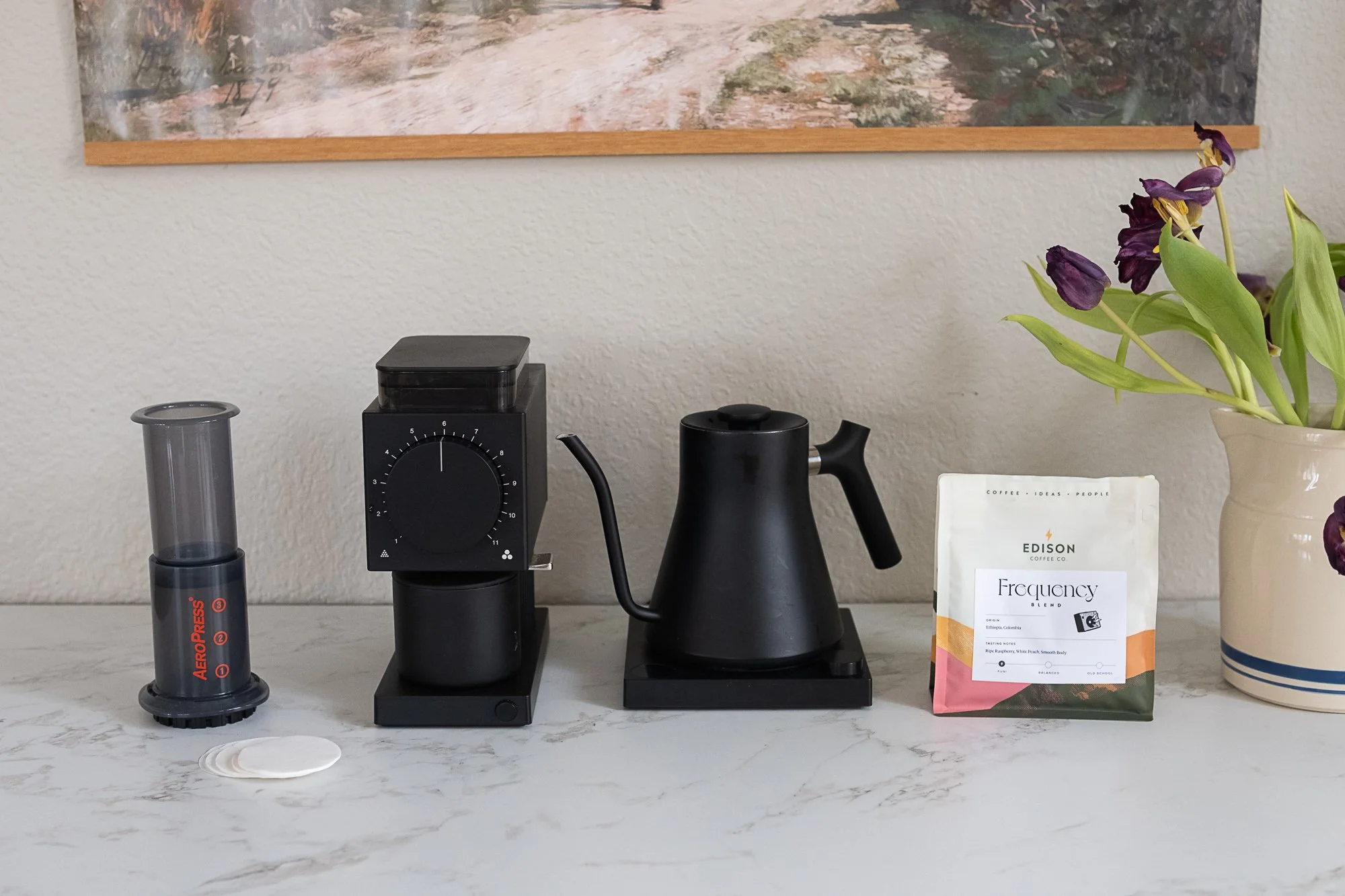Edison Coffee Brew Guide: The Aeropress
We’re capping our series of brewing guides with a fan favorite in the specialty coffee industry: the tiny-but-mighty Aeropress! For many coffee-lovers, including myself, this was the brewer that got us into craft coffee. Not only is the aeropress fun and simple to use, but it is capable of producing a quality, full-bodied cup of coffee that’s hard not to enjoy.
You may be surprised by the idea that the inventor of the aerobie frisbee (yes, you read that right) would have any business contributing to the coffee industry in a meaningful way; in fact, the aeropress boasts clever and well-informed design. Like the French Press or Cold Brew, the aeropress steeps grounds in water for an extended period of time. However, rather than being plunged by a metal filter or drained down by gravity alone, it uses air pressure from a tight plunger to push the immersed grounds through the filter in a manner akin to espresso. The result is a bright, concentrated cup of coffee that can either be enjoyed on its own or diluted to make an americano.
The aeropress is also very flexible. Its wide margin of error allows for tons of experimentation and fine-tuning in your recipe. The purpose of this guide is to give you enough know-how for the aeropress using basic fundamentals, so that you may have the tools you need to develop your own recipe further. We hope that you find this little brewer as fun and as exciting as we do. Let’s read on!
Materials Needed
Aeropress Brewer: There are currently two types of aeropress brewers available. There is the original brewer and the slightly smaller Aeropress Go, which comes nestled within a little travel cup. Either one will work, but this recipe was designed to be compatible with the lower volume of the Aeropress Go. Both models also include paper filters in their packaging!
Grinder: Once more, we recommend a burr grinder like the Baratza Encore. A hand-grinder may also be suitable, due to their tendency to naturally grind on the finer side.
Kettle: A gooseneck is ideal because of its ability to adjust temperature and narrow spout, but you can theoretically use any type of kettle, as pour rate is inconsequential with the aeropress.
A timer or stop-watch
Scale
Mug or serving vessel: The aeropress rests on top of the vessel it filters into. Therefore, you can either press the coffee directly into your coffee mug, or into a carafe.
Coffee: The aeropress works well with any specialty coffee. We’ve tested it on our Telegraph blend as well as on our fruitier SOs and were equally impressed. It will ultimately come down to preference for you!
Water: Filtered water is ideal for the aeropress. We want the natural solvents in the coffee to be clearly present after extraction, free from combatting elements in the water that might muddle the coffee’s flavor.
Instructions
Preheat the Kettle to about 200 degrees Fahrenheit.
Weigh out coffee: We’ll be using a 1:15 ratio. Weigh out 12 grams of coffee.
Grind coffee: The aeropress grind should be coarser than espresso, but still on the finer side.
Grind size for an aeropress
What the inverted method looks like.
Place plunger lightly into the aeropress and turn the brewer upside down. The brewer should be resting in an inverted position upon your scale: The inverted method is an alternative way of making coffee with an aeropress, but yields arguably better results. We will discuss the difference between the regular method and the inverted method further below.
Pour grinds into inverted aeropress and tare the scale.
Start your timer and begin pouring: You will want to fill your aeropress until it reaches 180 grams of water. Give the coffee three good stirs and let it stand.
Wait two minutes. In the meantime, wet your paper filter, which should rest in the cap that screws into the aeropress: As the time gets closer to two minutes, go ahead and screw the cap in.
Give ‘er a good turn.
Slowly rotate the Aeropress three times, then place it right-side-up again ontop of your vessel of choice: The rotations will help to ensure that the grounds are fully immersed. When turning the Aeropress over, make sure to do so carefully, not pulling the plunger out and spilling wet coffee grounds all over the place.
Begin the plunge: The press should be met with some resistance, but too much resistance or too little should be an indication of either a too-fine grind or too-coarse. Press until you hear a hissing sound. This is the air passing through the filter and means that your brew is ready.
Enjoy! Add some hot water if you’d like, which will dilute the concentration and increase its volume.
Notes
The same extraction theories that we’ve used with past brew guides are applicable here as well: If the coffee tastes too bitter, coarsen your grind. Alternatively, fine up your grind if the coffee tastes too sour.
A note on the inverted method vs. the traditional method: The standard aeropress method requires you to pour your water and let it steep in an upright brewer. Although this will not ruin the taste of your coffee, it may cause the coffee to taste a little less extracted. As the coffee is steeping, it is also draining into the serving vessel on its own accord, due to gravity. This means that grounds at the bottom of the aeropress are not staying immersed in the water for as long as the grounds on the top are, which can yield an inconsistent cup. The inverted method addresses this problem by having the plunger keep the grounds from draining until it’s time for to press. This should make your coffee taste more consistent when you drink it.
Conclusion-Next Steps
As we said above, the aeropress rewards experimentation. People have used the Aeropress to make iced lattes, americanos, and even cold brew concentrate. In order to understand how to best use the aeropress for such possibilities, we recommend adjusting different variables to see how it might affect your recipe. For example, you might want to adjust your steep time, dosage, or volume of water used. From there, it’s just a hot skip and a jump away from slaying competitive aeropress tournaments.





